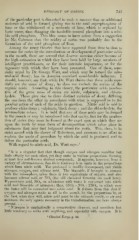Page 735 - My FlipBook
P. 735
ETIOLOGY OF CARIES. 745
of the particular part is disturbed in such a manner that an additional
molecule of acid is formed, giving rise to the acid superphosphate of
lime or the withdrawal of a molecule of lime, which is replaced by
basic water, thus changing the insoluble neutral phosphate into a solu-
ble acid phosphate. This idea seems to have arisen from a suggestion
by Mr. Coleman that the acidity of caries was probably due to the
formation of the acid phosphate of lime.
Among the many theories that have appeared from time to time to
account for caries by the introduction or development of particular acids
in the mouth, there are several that deserve mention either because of
the high estimation in which they have been held by large numbers of
intelligent practitioners, or for their intrinsic importance, or for the
ingenuity with which they have been presented. One of these, espe-
cially urged by Dr. George Watt, and which may be termed the min-
eral-acid theory, has in America exercised considerable influence. I
should, however, say that, while Dr. Watt claims that these acids espe-
cially are the cause of decay, he does not exclude the action of the
organic acids. According to this theory, the particular acids produc-
tive of. the great mass of caries are nitric, sulphuric, and chloro-
hydric. These give rise to three distinct varieties of decay, differing
the one from the other in accordance with what is supposed to be the
peculiar action of each of the acids in question. Nitric acid is said to
produce white decay ; sulphuric, black decay ; and the chlorohydric, the
intermediate colors. It is held that any of these acids may be formed
in the mouth or may be introduced into that cavity, but for the produc-
tion of caries they must be formed at the exact spot at which they act
upon the tooth by some form of decomposition which takes place in
substances that may fincl lodgment about the teeth. This, then, is in
strict accord with the theory of Robertson, and amounts to an effort to
explain the mode of procedure by which the acid is produced and to
define the particular acids.
With regard to nitric acid, Dr. Watt says : ^
"It is a singular fact that though oxygen and nitrogen manifest but
little affinity for each other, yet they unite in various proportions, forming
at least five well-known distinct compounds. It appears, however, from a
variety of circumstances, that their tendency is to unite in the proportions
which form nitric acid. The protoxyd is readily decomposed, and yields
nitrogen, oxygen, and nitrous acid. The binoxide, if brought in contact
with the atmosphere, takes from it two equivalents of oxygen, and also
becomes nitrous acid, or NO4 (the old chemical formulae are used here).
Hyponitrous acid, NO^, on admixture witli water is converted into nitric
acid and binoxide of nitrogen ; thus, 3NO3 = NO5 + 2N0.2, in which case
the latter will be converted into nitric acid. It follows from this that if
oxygen, and nitrogen unite at all in the mouth, let the proportions be, at
the first, what they will, nitric acid must be the ultimate result, as air and
moisture, the only agents necessary in the transformation, are here always
present
" Nitrogen is emphatically a conservative element, and manifests but
little tendency to unite with anything, and especially with oxygen. It is
^ Chemical Essays, p. 62.


